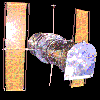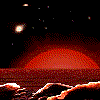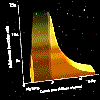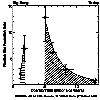Hubble Space Telescope

Last update: October 27, 1997
Intergalactic Stars
 |
This is an artist's concept of the view of the
nighttime sky from the surface of a hypothetical planet orbiting an "intergalactic"
star in the Virgo cluster of galaxies. Hubble Space Telescope discovered
600 similar "outcast" stars in a small region in the Virgo cluster, 60
million light-years away from Earth. The stars detected are all bright
red-giants. Many more dimmer stars, beyond Hubble's detection, may be among
the galaxies, as well, suggesting this population of "lone stars" accounts
for 10 percent of the cluster's mass. |


|
Hubble Census Tracks a Stellar "Baby Boom"
These graphs trace the history of the rate of star formation over the
past 12 billion years fromt relatively shortly after the birth of the universe
to the present.
Data from Hubble observations (left) show a steep rise in star formation
rate thar happened shortly after the big bang, while data from ground-based
observatories (right) show the precipitous decline in star formation rate
started from about 9 billion years to present. The maximum rate, perhaps
as high as 15 times today's rate, must be in the gap between these two
data sets. |
Hubble Space Telescope Completes Sixth Year of Exploration
A new golden era of space exploration and discovery
began April 24, 1990, with the launch and deployment of NASA's Hubble Space
Telescope.
Over the past six years Hubble's rapid-fire rate of unprecedented discoveries
has invigorated astronomy. Not since the invention of the telescope nearly
400 years ago have astronomers' vision of the universe been so revolutionized
over such a short stretch of time. Unburdened of distortion by our atmosphere,
nearly everywhere the 12.5-ton Earth orbiting observatory looks into space,
new details about planets, stars, and galaxies come into crystal clear
view.
Hubble has helped confirm some astronomical theories, challenged others,
and more often than not, comes up with complete surprises for wich theories
do not yet even exist.
This recent Hubble pictures released by the Space Telescope Science
Institute highlight its range of research and give a peek at the awesome
beauty of space. They include:
 A star cluster 2.2 million light-years away
A star cluster 2.2 million light-years away
 A mysterious gravitational lens
A mysterious gravitational lens
 The planet Saturn with rings tilted edge-on
The planet Saturn with rings tilted edge-on
 The planet Uranus seen in detail, surpassed only by interplanetary space
probes
The planet Uranus seen in detail, surpassed only by interplanetary space
probes
Some Hubble "firsts"
Hubble surprises
Some of the Hubble Findings that Have Earned a Place in Astronomy History
-
Massive black holes are real, and may be commonly
found in the core of galaxies.
-
The first stages of planet formation are common among stars.
-
The dark spot in Neptune's atmosphere is transient. It dissappeared frome
one hemisphere, and a new spot emerged in the opposite hemisphere.
-
Jupiter's icy moon, Europa, has a thin oxygen atmosphere.
-
A belt of hundreds of milions of comets encircles the solar system.
Unsolved mysteries:
These Hubble Findings Have Yet To Be Fully Explained.
Hubble Trivia
-
Hubble Space Telescope has observed approximately 8000 celestial objects.
That's nearly the total number of stars that can be seen from Earth with
naked eye.
-
2.5 trillion bytes of science data from Hubble observations are stored
on 375 optical disks.
-
Hubble relies on an adress book with the precise locations of 15 million
stars to allow it to lock onto celestial targets.
-
At least 1000 scientific papers have been published on Hubble science findings
by astronomers from more than 35 countries.
-
Hubble has circled Earth about 37000 times, racking up a total "mileage"
of 800 million miles.
Latest HST Observations
Click here for questions and
messages.


 A star cluster 2.2 million light-years away
A star cluster 2.2 million light-years away
 A mysterious gravitational lens
A mysterious gravitational lens
 The planet Saturn with rings tilted edge-on
The planet Saturn with rings tilted edge-on
 The planet Uranus seen in detail, surpassed only by interplanetary space
probes
The planet Uranus seen in detail, surpassed only by interplanetary space
probes